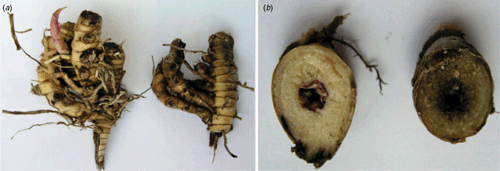First report of Miscanthus × giganteus rhizome rot caused by Fusarium avenaceum, Fusarium oxysporum and Mucor hiemalis
G. Beccari A , L. Covarelli A C , V. Balmas B and L. Tosi AA Università degli Studi di Perugia, Dipartimento di Scienze Agrarie e Ambientali, Borgo XX Giugno, 74 - 06121 Perugia, Italy.
B Università degli Studi di Sassari, Dipartimento di Protezione delle Piante, Via E. De Nicola, 9 - 07100 Sassari, Italy.
C Corresponding author. Email: lorenzo.covarelli@unipg.it
Australasian Plant Disease Notes 5(1) 28-29 https://doi.org/10.1071/DN10011
Submitted: 22 January 2010 Accepted: 4 March 2010 Published: 24 March 2010
Abstract
In 2007, after the failure of establishment of a miscanthus experimental field, rhizome rot was observed and several fungi were isolated from diseased tissue, namely Fusarium avenaceum, F. oxysporum and Mucor hiemalis. All three fungi proved to be causal agents of the disease. This is the first report of a miscanthus rhizome rot caused by F. avenaceum, F. oxysporum and M. hiemalis.
Miscanthus × giganteus, a sterile triploid interspecific hybrid originating from East Asia, has been experimentally cultivated in central Italy since 2007 as a potential crop for biomass production, and an alternative crop to tobacco. In May 2007, an estimated 90% of transplanted rhizomes failed to establish 30 days after planting in an experimental field trial (0.2 ha) located at Papiano (42°57′N, 12°22′E, 165 m a.s.l.), near Perugia in Umbria (central Italy). The affected rhizomes showed an extensive soft and/or dry rot, accompanied by a brownish discolouration, and absence of viable buds and roots (Fig. 1a). Cross-sections of the symptomatic rhizomes showed that the discolouration affected cortical and inner tissues (Fig. 1b).

|
Isolations were made onto potato dextrose agar (PDA) from field-affected rhizomes and remnants of the commercial lot, imported from England. Three fungi were consistently isolated: two Fusarium spp. and one Mucor sp. The species were identified morphologically as Fusarium avenaceum (FA), F. oxysporum (FO, accession number DSAA 1–07) (Burgess et al. 1994; Leslie et al. 2006) and Mucor hiemalis (MH, accession number DSAA 2–07) (Schipper 1973). The identification of F. avenaceum was confirmed by sequencing of the elongation factor gene (EF-1α), at the Centraalbureau voor Schimmelcultures, Utrecht, The Netherlands (accession number CBS 122702).
Ten-day-old colonies of each isolate, derived from single-spore isolations, were used to produce the inoculum for pathogenicity tests. Ten healthy rhizomes were immersed in spore suspensions (106 spores/mL) of each isolate for 45 min. Mixed inoculations were also performed with the three isolates together. Ten rhizomes immersed and non-immersed in sterile deionised water were used as controls. All the rhizomes were planted in 10-cm diameter pots (1 rhizome per pot) containing 360 g of a sterilised 1 : 1 sandy-peat soil. All the pots were placed in a growth chamber at an alternating day/night temperature of 22/20°C ± 2°C, 60–70% relative humidity and 16 h of artificial light.
Significant emergence reduction, low shoot development, length and number of roots and rhizome rot occurred by 3–4 weeks after single inoculations. In particular, rhizome rot incidence was 67%, 35%, 25%, respectively for FA, MH, FO and 2.6% in the control. Similar results were obtained with mixed inoculations. The three fungal species were consistently reisolated from inoculated rhizomes. The controls showed minimal symptoms and appeared healthy.
Other Fusarium species have also been reported on miscanthus: F. miscanthi was reported in Denmark from straw of M. sinensis (Gams et al. 1999) and F. culmorum and F. proliferatum were reported in central Europe as causal agents of rhizome rot (Goßmann 2000). This is the first report of a rhizome rot caused by these three pathogens, presumably due to contamination in the field and improper rhizome storage conditions (high temperature and humidity). These findings should be taken into consideration when commercialising miscanthus rhizomes.
Acknowledgements
This work was supported by the European Union and the Italian Ministry of Agriculture (CO.AL.TA.2 Project).
Gams W,
Klamer M, O’Donnell K
(1999) Fusarium miscanthi sp. nov. from Miscanthus litter. Mycologia 91(2), 263–268.
| Crossref | GoogleScholarGoogle Scholar |

Schipper MAA
(1973) A study on variability in Mucor hiemalis and related species. Studies in Mycology 4, 1–40.



